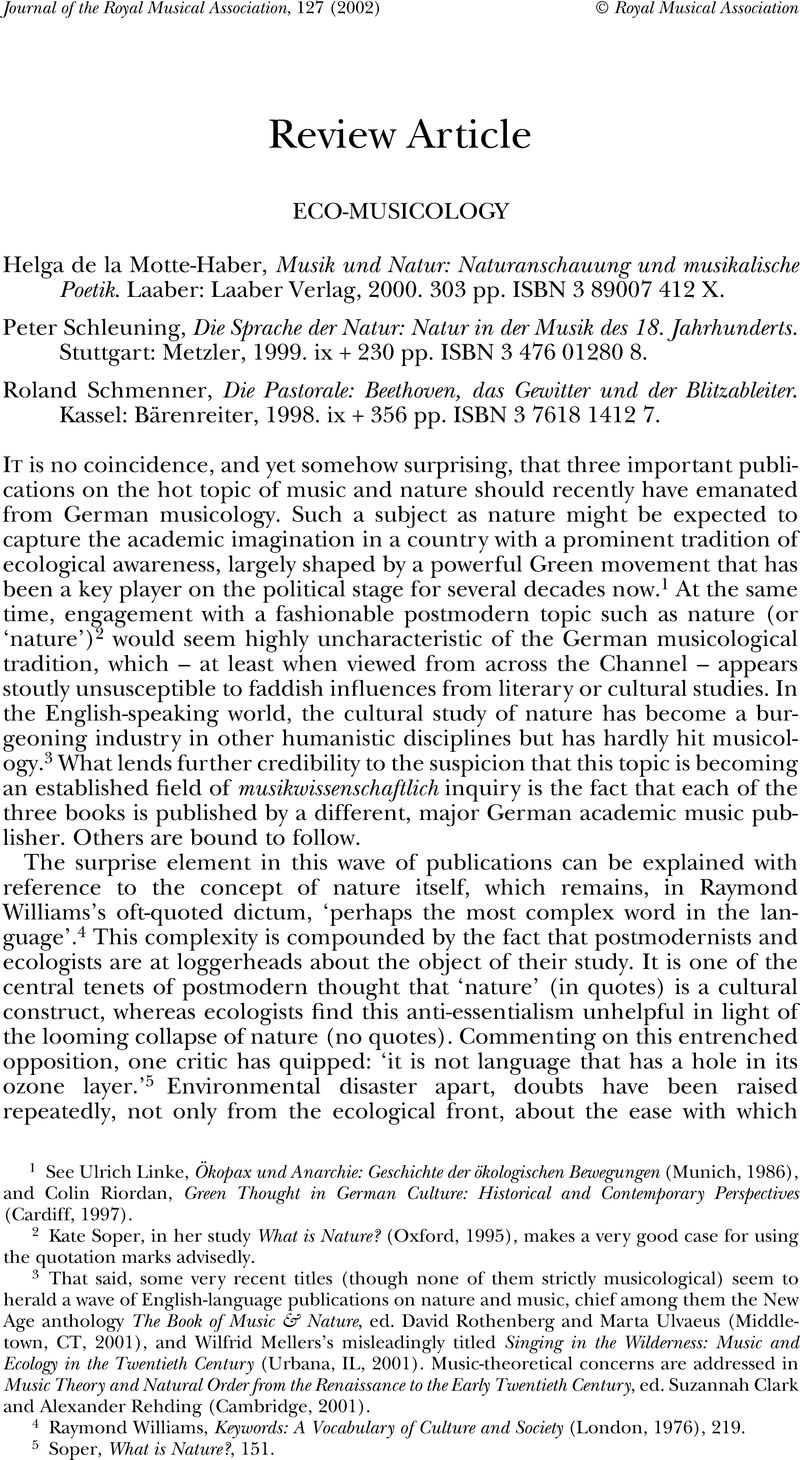Article contents
Abstract

- Type
- Review Article
- Information
- Copyright
- Copyright © Royal Musical Association, 2002
References
1 See Linke, Ulrich, Ökopax und Anarchie: Geschichte der ökologischen Bewegungen (Munich, 1986), and Colin Riordan, Green Thought in Germain Culture: Historical and Contemporary Perspectives (Cardiff, 1997).Google Scholar
2 Kate Soper, in her study What is Nature? (Oxford, 1995), makes a very good case for using the quotation marks advisedly.Google Scholar
3 That said, some very recent titles (though none of them strictly musicological) seem to herald a wave of English-language publications on nature and music, chief among them the New Age anthology The Book of Music & Nature, ed. David Rothenberg and Marta Ulvaeus (Middle-town, CT, 2001), and Wilfrid Mellers's misleadingly titled Singing in the Wilderness: Music and Ecology in the Twentieth Century (Urbana, IL, 2001). Music-theoretical concerns are addressed in Music Theory and Natural Order from the Renaissance to the Early Twentieth Century, ed. Suzannah Clark and Alexander Rehding (Cambridge, 2001).Google Scholar
4 Raymond Williams, Keywords: A Vocabulary of Culture and Society (London, 1976), 219.Google Scholar
5 Soper, What is Nature?, 151.Google Scholar
6 See Eagleton, Terry, The Idea of Culture (Oxford, 1999), 92.Google Scholar
7 See Soper, What is Nature?, 15.Google Scholar
8 Williams, Keywords, 219. See also his ‘Ideas of Nature’, Problems in Materialism and Culture (London, 1997), 67–85.Google Scholar
9 Peter Jona Korn, Musikalische Umweltverschmutzung (Munich, 1976); Friedrich Blume, Was ist Musik? (Kassel, 1959). For an early critique of nature as a legitimizing authority in music theory, see also Carl Dahlhaus, Die Musiktheorie im 18. und 19. Jahrhundert, i: Grundzüge einer Systematik (Darmstadt, 1986), 37–42.Google Scholar
10 See Coates, Peter, Nature (Cambridge, 1998), 185.Google Scholar
11 For a critique of ecological history, see ibid., particularly pp. 67–81.Google Scholar
12 Claus Bockmaier, Entfesselte Natur in der Musik des achtzehnten Jahrhunderts (Tutzing, 1992).Google Scholar
13 For de la Motte-Haber's further discussion of nature not as the ‘other’, see also pp. 18 and 46.Google Scholar
14 See Peter le Huray and James Day, eds., Music and Aesthetics in the Eighteenth and Early-Nineteenth Centuries (Cambridge, 1981), 17.Google Scholar
15 See Schleuning's methodological musings – presumably an implicit response to a dissenting reader for the press – at the end of this chapter, Die Sprache der Natur, 56–8. The methodological discussion is taken up again in an exchange between Schleuning and Anselm Gerhard in Die Musiktheorie, 14 (1999), 278–80, 370–1.Google Scholar
16 It is notable that this traditional notion of personal influence is nevertheless making a reentry in musicology through the back door, in the guise of misreadings – usually of the ‘weak’ kind – of Harold Bloom's Anxiety of Influence.Google Scholar
17 Occasionally, however, Schmenner himself succumbs to the seductive rhetoric of influence, particularly in passages of close analysis. Thus we read: ‘Brahms may have had this passage [4th movement, bars 103–6] before his inner eye when he composed the first symphony’ (p. 61) and ‘If we cast the net very widely, the origin of Arvo Pärt's esoteric music may be marked here [1st movement, bars 151–238]‘ (p. 116).Google Scholar
18 Kofi Agawu, Playing with Signs: A Semiotic Interpretation of Classic Music (Princeton, 1991); Leonard Ratner, Classic Music: Expression, Form, and Style (New York, 1980).Google Scholar
19 Friedrich Kittler, ed., Die Austreibung des Geistes aus den Geisteswissenschaften: Programme des Poststrukturalismus (Paderborn, 1980).Google Scholar
20 Schmenner's publishers are doing him no favours when they advertise his book as suitable ‘for readers with an interest in cultural or music history who want to find out more about the general change of the understanding of nature and Beethoven's artistic engagement with everyday experiences’.Google Scholar
21 Charles Rosen, The Classical Style (London, 1971), 402.Google Scholar
22 For a detailed discussion of the establishment of the supremacy of instrumental music and the ‘true German style’ around C. P. E. Bach and Haydn in English, see particularly Mary Sue Morrow, German Music Criticism in the Late Eighteenth Century: Aesthetic Issues in German Music (Cambridge, 1997).Google Scholar
23 Anselm Gerhard draws attention to this in ‘Natur als Stoff der Musik? Ein ästhetisches Problem und seine Folgen für die Musikgeschichte’, Neue Zürcher Zeitung (20–1 June 1998), 85.Google Scholar
24 See particularly Thomas Christensen, Rameau and Musical Thought in the Enlightenment (Cambridge, 1993).Google Scholar
25 Consider his opera Pigmalion, which opens with the magical moment where Pigmalion's statue comes to life, causing Pigmalion himself to pose the amazed question: ‘D'où naissent ces accords?’ What he hears around him, and the audience with him, in this miraculous synaesthetic experience is the corps sonore – not just a tonic chord, but rather a representation of the corps sonore in almost precisely its exact registral disposition. The scientifically derived sound of nature, its simulation as a realistic event on the stage, and the supernatural cause for its sounding all come together in this French operatic moment of Enlightenment. (See Christensen, Rameau and Musical Thought, 218–41, and Brian Hyer, ‘Sighing Branches: Prosopopoeia in Rameau's Pigmalion’, Music Analysis, 13/1 (1994), 7–50. See also Charles Dill, Monstrous Opera (Princeton, 1997).)Google Scholar
26 See Sterne, Laurence, Tristram Shandy, IX, chapter 24. I am grateful to Suzanne Aspden for drawing my attention to this point, as well as making a number of other helpful suggestions elsewhere in the text.Google Scholar
27 Simon Schama, Landscape and Memory (London, 1996), 61.Google Scholar
28 Arnold Schering, Das Symbol in der Musik (Leipzig, 1941), 122.Google Scholar
29 See Ingolfur Blühdorn, ‘Ecological Thought and Critical Theory’, Green Thought in German Culture, ed. Riordan, 89–106.Google Scholar
30 On the topic of the sublime in the context of recent German scholarship, see particularly Christine Pries, ed., Das Erhabene: Zwischen Grenzerfahrung und Größenwahn (Weinheim, 1989).Google Scholar
- 7
- Cited by




